Hoping to beat the next bout of rain to check on my little shorebird hotspot, I made it to my car just as the biggest downpour of spring let loose, bombarding the area with a fast and furious dose of golden rain – golden because it will make everything grow for weeks ahead. My clothes, shoes, and hair were drenched as I ran from the car back to the house, where I would slip back into my photo editing mode for the next issue, feeling pretty damp. In about an hour a ray of sunshine broke through the clouds, and I quickly shifted gears and drove north 2 miles to the drying bay on the south side of Bobby’s Lake.
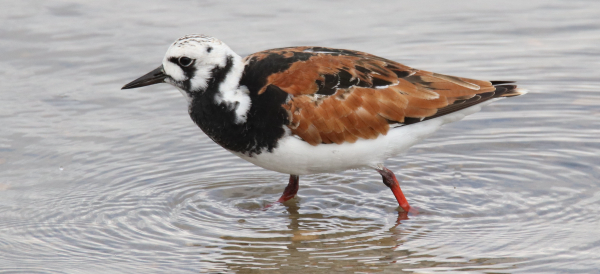
Perhaps the earlier rain shortstopped some new birds, and what I saw there gave me a shot of adrenaline as I reached for my camera even before stopping my car. Ruddy Turnstones, a Hudsonian Godwit, Stilt Sandpipers, and a variety of smaller sandpipers including Dunlins in full color. The 7 Ruddy Turnstones caught my attention first, so I parked near a finger of mud that broke the shoreline by extending into the shallows, just 15 feet away from my car’s window at that point. I wouldn’t have stopped that close, but I didn’t realize these turnstones were present, having fixated on the 7 on the other side of the little bay. The colorful turnstones were vying for position along the sides of the mudbar, along with Dunlins, Stilt Sandpipers, Semipalmated Sandpipers, a Pectoral Sandpiper, American Avocets, and even a few Blue-winged Teal.
Mostly focused on the Ruddy Turnstones to begin with, they were filling my photo frame of my camera at that point and the action was heated with other shorebirds active around them. Suddenly I was jolted to another level of excitement as a Hudsonian Godwit landed at the edge of the finger of mud – WoW! Are you kidding me? I thought the Hudsonians were all in Canada by now, after not seeing one for a couple weeks. This was a male with an incomplete molt, even now, so perhaps it was a young male, even a yearling. With the sunlight slipping in and out of the edge of rain clouds, I focused on the Arctic godwit, fresh from South America perhaps, and managed some of the best images of a Hudsonian Godwit during this shorebird spring.
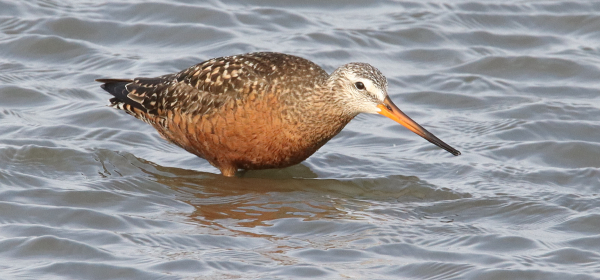
The shorebirds were very active and very edgy, reacting to every passing cattle truck or grain truck by flushing, circling once or twice, then repositioning in the bay. But the turnstones, Dunlins, and Baird’s Sandpipers eventually returned to the finger of mud, which must have been filled with small invertebrates considering the number of birds frantically feeding there. That’s when I noticed 2 sandpipers land at the far end of the shallow bay that showed a tan color that caught my attention – and sure enough, they were Buff-breasted Sandpipers, another super-rare shorebird that winters in southern South America and nests in the Arctic tundra.
Considering that I’ve only seen Buff-breasted Sandpipers 3 times before, this was a sighting to celebrate – just as I celebrated the first spring migration sighting of American Golden Plovers, and Hudsonian Godwits, which are similarly hard to encounter in the vast northern Great Plains during a rare migration stopover. I’ve only seen Ruddy Turnstones twice before, so this was an especially exciting birding period – and it wasn’t over! As clouds slipped in and out to reveal sunlight, then shade it, I looked up from photographing at close range to see a single American Golden Plover across the little bay, wading, drinking, then bathing!

During the shorebird parade, 4 groups of Buff-breasted Sandpipers visited the little bay, but none approached close enough for quality photographs. Nonetheless, a documentary photo illustrates a male displaying toward a female within a loose flock of 6 (600mm zoom lens, f-11 aperture, 1/800 shutter speed, 800 ISO).
|
In last week’s Bird Photography feature, I referred to the spring shorebird “Trifecta” as the American Golden Plovers, Hudsonian Godwits, and Buff-breasted Sandpipers. I truly couldn’t imagine they would all appear in the same little bay, less than 2 miles from home – now along with an equally rare observation of Ruddy Turnstones during a mid-continental spring migration stop! Let’s refer to the all as the “Fantastic Four!”
Photo Challenges
With the exception of the Buff-breasted Sandpipers, there was little problem getting close to the rare species, which is usually the primary concern or interest when trying to photograph rarely encountered migrants. This particular day it was the sunlight that was fleeting, on a day when low rainclouds dominated. But somehow, someway, far beyond my control, the sunlight always seemed to break through during pivotal opportunities to photograph the rare species. It was possible to photograph the 3 larger species at close range – close enough for my zoom lens – and when the birds were close, the clouds always seemed to thin or break away, if only for a couple minutes. And during those precious moments, I had a one-track focus on the bird or birds on hand. As always, luck and timing played a big part in bird photography.
As for the Buff-breasted Sandpipers, they presented the biggest challenges, primarily related to being super-wary and uninterested in feeding in the bay. In the case of Buff-breasts, and most often the Golden Plovers, they came to the water to drink and bathe, so they didn’t spend much time there. Plus, the Buff-breasted Sandpipers always landed at the far corner of the bay – out of range of getting a single quality photo of the birds. The light was never very good either, but I took documentary photos of the Buffs, and I was thrilled to witness their exceptional mating displays.
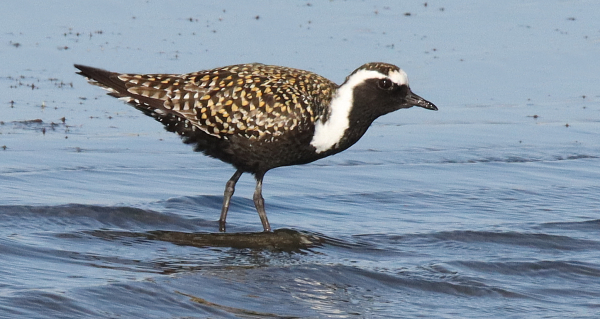
I have always been enchanted with the males’ cupped wing display in which a male faces a female, extends his wings forward at an upturned elevation, and at the peak of the display, he points his short, thin beak to the sky – very impressive. When one of the Buff-breasted Sandpipers began to perform this display I quickly reacted, attempting to get a documentary photo from a distance, thinking that perhaps I could enlarge the image by cropping extraneous background, but the images didn’t stay sharp in the process. Even so, it was something of a breakthrough to see the male display, and to get even a poor image, which I share here. Having only witnessed the display during 1 of the previous 2 encounters with the species, now I can hope to improve on the quality of future images, should another opportunity arise.
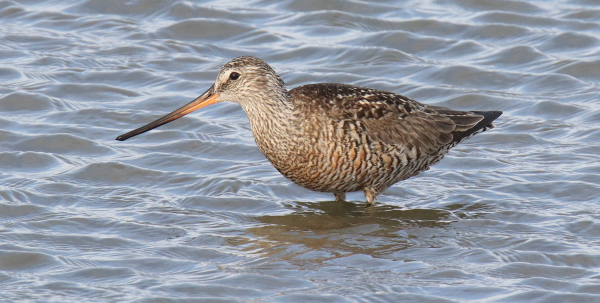
The background water was moderately pleasing, with shades of gray, white, and gray-blue mixed; but in a couple images the reflected colors in the water were quite nice. The varied wind action on the water surface always adds an element to photos, good and not so good. But overall, water usually is a pleasing background that helps to show birds in their feeding or resting habitat, and helps to “pop” them out of their surroundings. I tried to emphasize action photos, but aside from wading and foraging in the mud beneath the water surface, I was only able to get a few flight photos of poor quality at best.
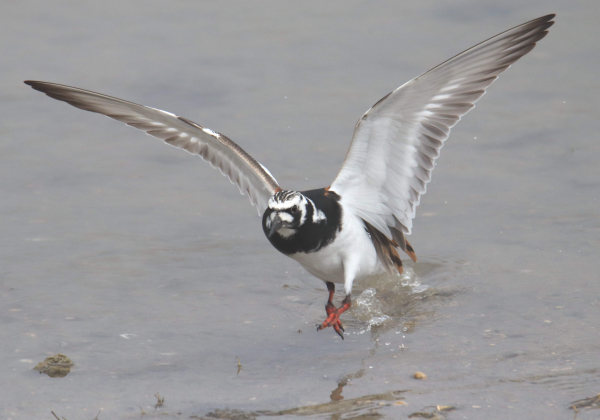
That said though, seeing these “rare migrants” during a mid-continent stop at a nearby mudflat was such a thrill – species by species. Other birds on hand included the Stilt Sandpipers, and a variety of smaller sandpipers including Dunlins in full color that I also photographed. The 7 Ruddy Turnstones caught my attention first as I parked near a finger of mud that extended from the shoreline into the shallows, just 20 feet away from my car’s window at that point. I wouldn’t have stopped that close, but I didn’t realize the turnstones were present until I was already slowing to a stop. The colorful turnstones were vying for position along the sides of the mudbar, along with Dunlins, Stilt Sandpipers, Semipalmated Sandpipers, a Pectoral Sandpiper, Wilson’s Phalaropes, 2 pairs of American Avocets, a pair of Marbled Godwits, and a Willet. Oh what fun it was!
Article and Photographs by Paul Konrad
Share your bird photos and birding experiences at editorstbw2@gmail.com